Influence of Silver Addition on Structure, Martensite Transformations and Mechanical Properties of TiNi–Ag Alloy Wires for Biomedical Application
Abstract
:1. Introduction
2. Materials and Methods
3. Results and Discussion
4. Conclusions
Author Contributions
Funding
Conflicts of Interest
References
- Eggeler, G.; Hornbogen, E.; Yawny, A.; Heckmann, A.; Wagner, M. Structural and functional fatigue of NiTi shape memory alloys. Mater. Sci. Eng. A 2004, 378, 24–33. [Google Scholar] [CrossRef]
- Jani, J.M.; Leary, M.; Subic, A.; Gibson, M.A. A review of shape memory alloy research, applications and opportunities. Mater. Des. 2014, 56, 1078–1113. [Google Scholar] [CrossRef]
- Hornbogen, E. Microstructure and Thermo-Mechanical Properties of NiTi Shape Memory Alloys. Mater. Sci. Forum 2004, 455, 335–341. [Google Scholar] [CrossRef]
- Shen, J.-J.; Lu, N.-H.; Chen, C.-H. Mechanical and elastocaloric effect of aged Ni-rich TiNi shape memory alloy under load-controlled deformation. Mater. Sci. Eng. A 2020, 788, 139554. [Google Scholar] [CrossRef]
- Gunther, V.E.; Chekalkin, T.L; Kim, J.S; Hodorenko, V.N. The Equilibrium Of Martensite Shear Stress At Phase Transistors In TiNi-Based Alloy. Adv. Mater. Lett. 2015, 6, 8–12. [Google Scholar] [CrossRef]
- Sakamoto, H. Distinction between Thermal and Stress-Induced Martensitic Transformations and Inhomogeneity in Internal Stress. Mater. Trans. 2002, 43, 2249–2255. [Google Scholar] [CrossRef] [Green Version]
- Mishnaevsky, L.; Levashov, E.; Valiev, R.Z.; Segurado, J.; Sabirov, I.; Enikeev, N.; Prokoshkin, S.; Solov’Yov, A.V.; Korotitskiy, A.; Gutmanas, E.; et al. Nanostructured titanium-based materials for medical implants: Modeling and development. Mater. Sci. Eng. R: Rep. 2014, 81, 1–19. [Google Scholar] [CrossRef]
- Gunther, V.; Radkevich, A.; Kang, S.B.; Chekalkin, T.; Marchenko, E.; Gunther, S.; Pulikov, A.; Sinuk, I.; Kaunietis, S.; Podgorniy, V.; et al. Study of the knitted TiNi mesh graft in a rabbit cranioplasty model. Biomed. Phys. Eng. Express 2019, 5, 027005. [Google Scholar] [CrossRef]
- Melaiye, A.; Youngs, W.J. Silver and its application as an antimicrobial agent. Expert Opin. Ther. Patents 2005, 15, 125–130. [Google Scholar] [CrossRef]
- Ruparelia, J.; Chatterjee, A.K.; Duttagupta, S.P.; Mukherji, S. Strain specificity in antimicrobial activity of silver and copper nanoparticles. Acta Biomater. 2008, 4, 707–716. [Google Scholar] [CrossRef]
- Zheng, Y.; Zhang, B.; Wang, B.; Wang, Y.; Li, L.; Yang, Q.; Cui, L. Introduction of antibacterial function into biomedical TiNi shape memory alloy by the addition of element Ag. Acta Biomater. 2011, 7, 2758–2767. [Google Scholar] [CrossRef] [PubMed]
- Oh, K.-T.; Joo, U.-H.; Park, G.-H.; Hwang, C.-J.; Kim, K.-N. Effect of silver addition on the properties of nickel-titanium alloys for dental application. J. Biomed. Mater. Res. Part B: Appl. Biomater. 2006, 76, 306–314. [Google Scholar] [CrossRef] [PubMed]
- Li, S.; Kim, Y.-W.; Nam, T.-H. Transformation behavior and superelastic properties of Ti-Ni-Ag scaffolds prepared by sintering of alloy fibers. Scr. Mater. 2018, 153, 23–26. [Google Scholar] [CrossRef]
- Momeni, S.; Tillmann, W. Influence of Ag on antibacterial performance, microstructure and phase transformation of NiTi shape memory alloy coatings. Vacuum 2019, 164, 242–245. [Google Scholar] [CrossRef]
- Jhou, W.-T.; Wang, C.; Ii, S.; Chiang, H.-S.; Hsueh, C.-H. TiNiCuAg shape memory alloy films for biomedical applications. J. Alloy. Compd. 2018, 738, 336–344. [Google Scholar] [CrossRef]
- Da Silva, G.; Álvares, O.J. Designing NiTiAg Shape Memory Alloys by Vacuum Arc Remelting: First Practical Insights on Melting and Casting. Shape Mem. Superelasticity 2018, 4, 402–410. [Google Scholar] [CrossRef]
- Marchenko, E.S.; Baigonakova, G.; Gyunter, V.E. The Effect of Silver Doping on the Structure and Shape Memory Effect in Biocompatible TiNi Alloys. Tech. Phys. Lett. 2018, 44, 749–752. [Google Scholar] [CrossRef]
- Zamponi, C.; Wuttig, M.; Quandt, E. Ni–Ti–Ag shape memory thin films. Scr. Mater. 2007, 56, 1075–1077. [Google Scholar] [CrossRef]
- Quandt, E.; Zamponi, C. Superelastic NiTi Thin Films for Medical Applications. Adv. Sci. Technol. 2008, 59, 190–197. [Google Scholar] [CrossRef]
- Thangavel, E.; Dhandapani, V.S.; Dharmalingam, K.; Marimuthu, M.; Veerapandian, M.; Arumugam, M.K.; Kim, S.; Kim, B.; Ramasundaram, S.; Kim, D.-E.; et al. RF magnetron sputtering mediated NiTi/Ag coating on Ti-alloy substrate with enhanced biocompatibility and durability. Mater. Sci. Eng. C 2019, 99, 304–314. [Google Scholar] [CrossRef]
- Chun, S.-J.; Noh, J.-P.; Yeom, J.-T.; Kim, J.-I.; Nam, T.-H. Martensitic transformation behavior of Ti–Ni–Ag alloys. Intermetallics 2014, 46, 91–96. [Google Scholar] [CrossRef]
- Li, S.; Kim, E.-S.; Kim, Y.-W.; Nam, T.-H. Microstructures and martensitic transformation behavior of superelastic Ti-Ni-Ag scaffolds. Mater. Res. Bull. 2016, 82, 39–44. [Google Scholar] [CrossRef]
- Jang, J.-Y.; Chun, S.-J.; Kim, N.-S.; Cho, J.-W.; Kim, J.-H.; Yeom, J.-T.; Nam, T.-H.; Kim, J.-I. Martensitic transformation behavior in Ti–Ni–X (Ag, In, Sn, Sb, Te, Tl, Pb, Bi) ternary alloys. Mater. Res. Bull. 2013, 48, 5064–5069. [Google Scholar] [CrossRef]
- Yi, X.; Pang, G.; Sun, B.; Meng, X.; Cai, W. The microstructure and martensitic transformation behaviors in Ti-Ni-Hf -X (Ag, Sn) high temperature shape memory alloys. J. Alloy. Compd. 2018, 756, 19–25. [Google Scholar] [CrossRef]
- Marchenko, E.; Baigonakova, G.; Kokorev, O.V.; Klopotov, A.; Yuzhakov, M.M. Phase equilibrium, structure, mechanical and biocompatible properties of TiNi-based alloy with silver. Mater. Res. Express 2019, 6, 066559. [Google Scholar] [CrossRef]
- Gunther, V.; Marchenko, E.S.; Chekalkin, T.; Baigonakova, G.; Kang, J.-H.; Kim, J.-S.; Klopotov, A. Study of structural phase transitions in quinary TiNi(MoFeAg)-based alloys. Mater. Res. Express 2017, 4, 105702. [Google Scholar] [CrossRef]
- Hua, Y.; Nie, Z.; Wang, L.; Zhang, H.; Wang, C.; Tan, C.; Wang, Y. Studies of intergranular and intragranular stresses in cold-rolled CuNiSi alloys. J. Alloy. Compd. 2020, 818, 152896. [Google Scholar] [CrossRef]
- Wang, Y.; Tian, H.; Stoica, A.D.; Wang, X.-L.; Liaw, P.K.; Richardson, J.W. The development of grain-orientation-dependent residual stressess in a cyclically deformed alloy. Nat. Mater. 2003, 2, 101–106. [Google Scholar] [CrossRef]
- Gunther, V.; Marchenko, E.; Baigonakova, G. Physical properties of the TiNi-based alloys doped with silver. Mater. Today: Proc. 2017, 4, 4727–4731. [Google Scholar] [CrossRef]
- Gyunter, V.E.; Marchenko, E.; Gyunter, S.V.; Baigonakova, G. The Influence of the Surface Layer on the Combination of Properties of Thin TiNi Alloy Wires. Tech. Phys. Lett. 2018, 44, 811–813. [Google Scholar] [CrossRef]
- Gunther, S.; Chekalkin, T.; Hodorenko, V.; Kang, J.H.; Kim, J.S.; Gunther, V. Impact of infrared radiation on oxide layer of ultrathin TiNi-based alloy wire. Adv. Mater. Lett. 2018, 9, 715–720. [Google Scholar] [CrossRef]
- Sharifi, E.M.; Kermanpur, A. Superelastic properties of nanocrystalline NiTi shape memory alloy produced by thermomechanical processing. Trans. Nonferrous Met. Soc. China 2018, 28, 515–523. [Google Scholar] [CrossRef]
- Povoden-Karadeniz, E.; Cirstea, D.; Lang, P.; Wojcik, T.; Kozeschnik, E. Thermodynamics of Ti–Ni shape memory alloys. Calphad 2013, 41, 128–139. [Google Scholar] [CrossRef]
- Otsuka, K.; Ren, X. Physical metallurgy of Ti–Ni-based shape memory alloys. Prog. Mater. Sci. 2005, 50, 511–678. [Google Scholar] [CrossRef]
- Gao, P.; Liu, Y.; Ren, Y.; Chen, G.; Lan, B.; Lu, X.; Li, C. Evaluation of the microstructure and property of TiNi SMA prepared using VIM in BaZrO3 crucible. Vacuum 2019, 168, 108843. [Google Scholar] [CrossRef]
- Khaleghi, F.; Tajally, M.; Emadoddin, E.; Mohri, M. The investigation of the mechanical properties of graded high-temperature shape memory Ti-Ni-Pd alloy. J. Alloy. Compd. 2019, 787, 882–892. [Google Scholar] [CrossRef]
- Lu, J.; Hu, Q.-M.; Yang, R. Composition-dependent elastic properties and electronic structures of off-stoichiometric TiNi from first-principles calculations. Acta Mater. 2008, 56, 4913–4920. [Google Scholar] [CrossRef]
- Wu, S.; Lin, H.; Chen, S. Phenomenological analysis of martensitic transformation in cold-rolled TiNi-base shape memory alloys. Mater. Chem. Phys. 2001, 68, 149–156. [Google Scholar] [CrossRef]
- Tsuchiya, K.; Inuzuka, M.; Tomus, D.; Hosokawa, A.; Nakayama, H.; Morii, K.; Todaka, Y.; Umemoto, M. Martensitic transformation in nanostructured TiNi shape memory alloy formed via severe plastic deformation. Mater. Sci. Eng. A 2006, 643–648. [Google Scholar] [CrossRef]
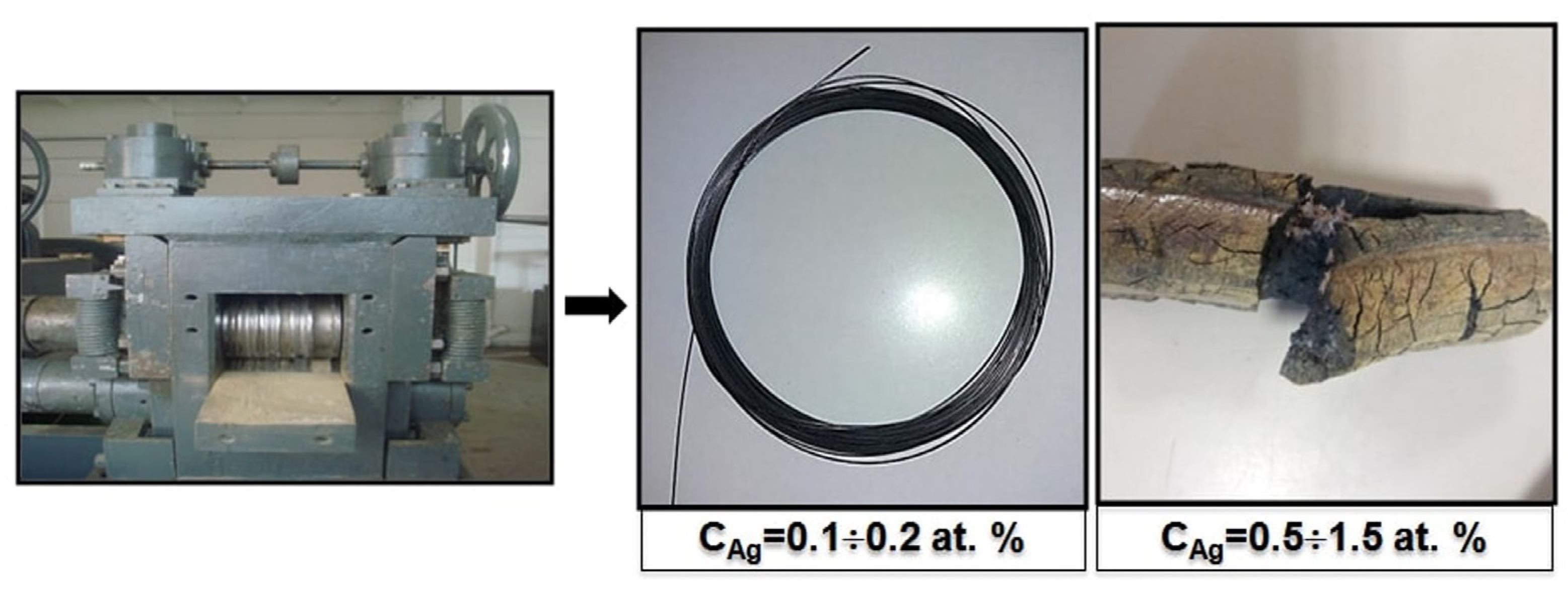
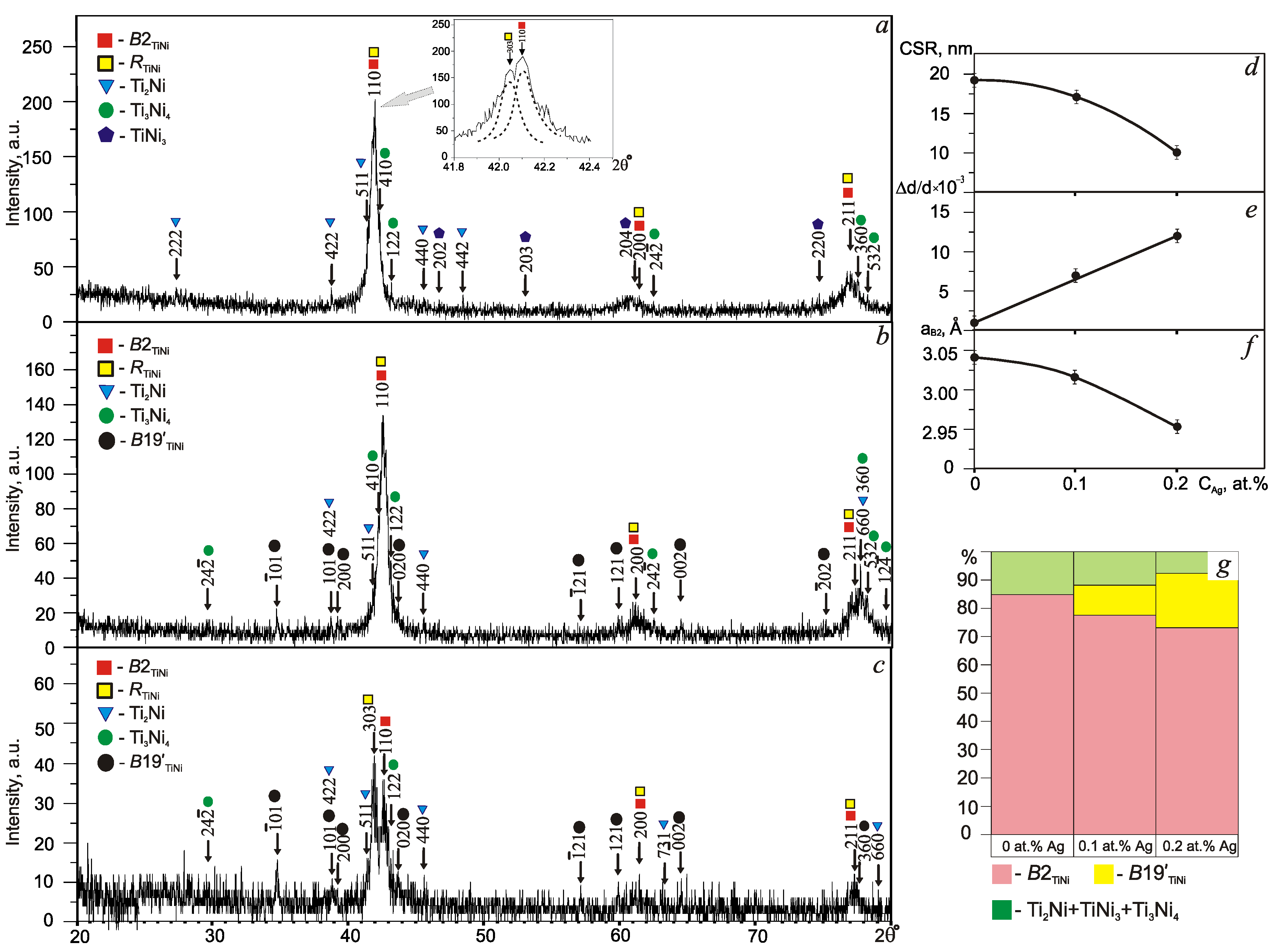

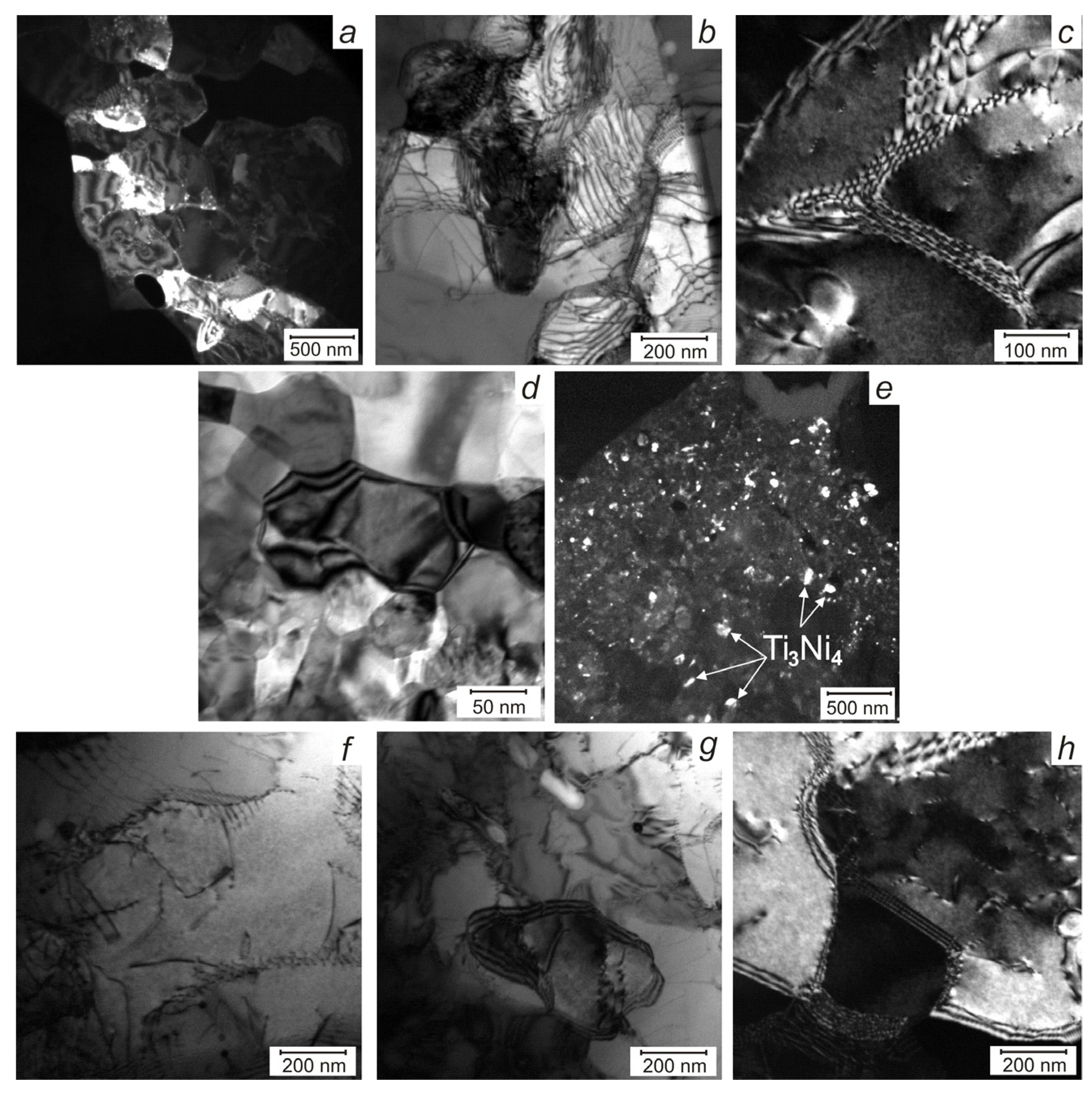
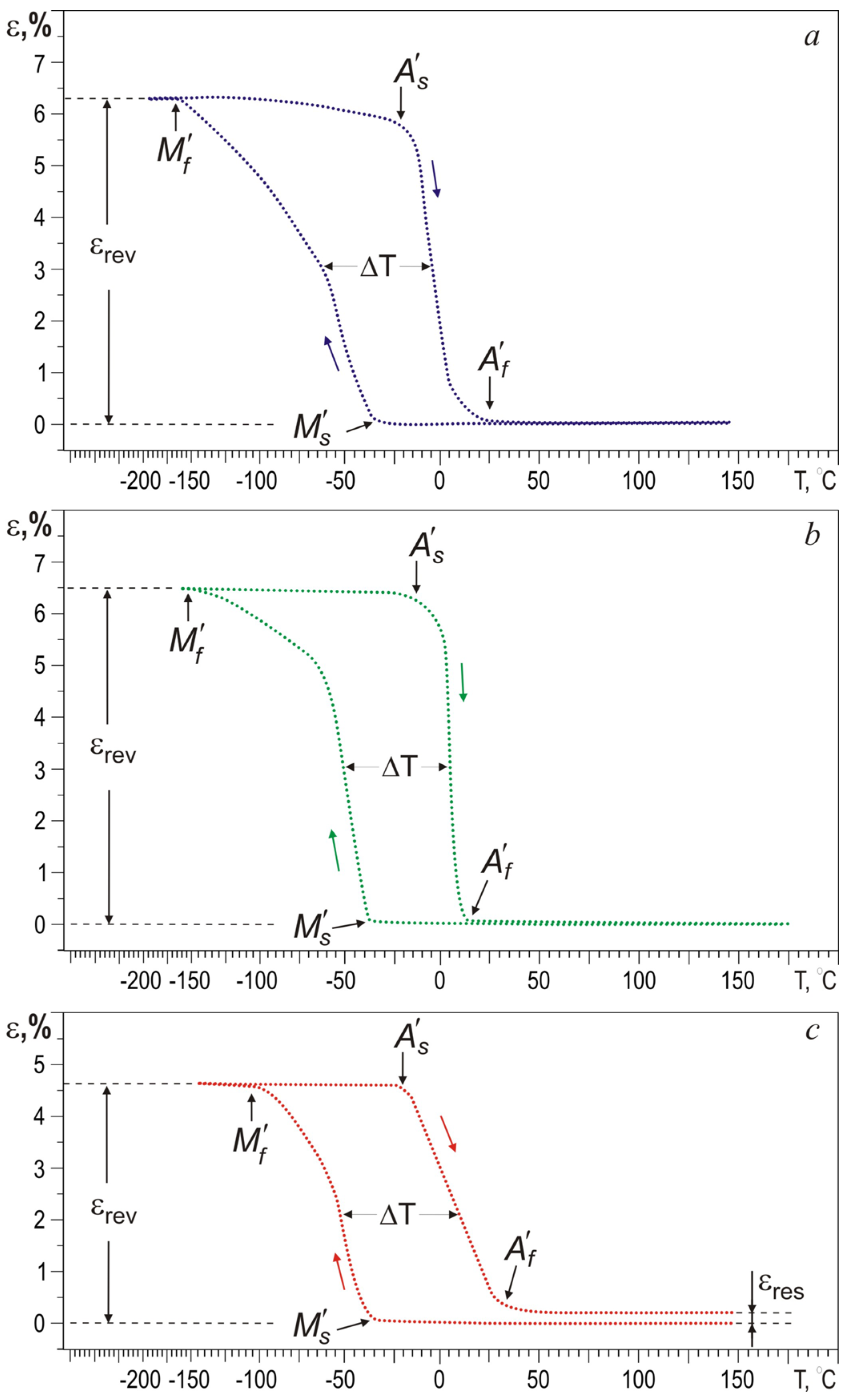
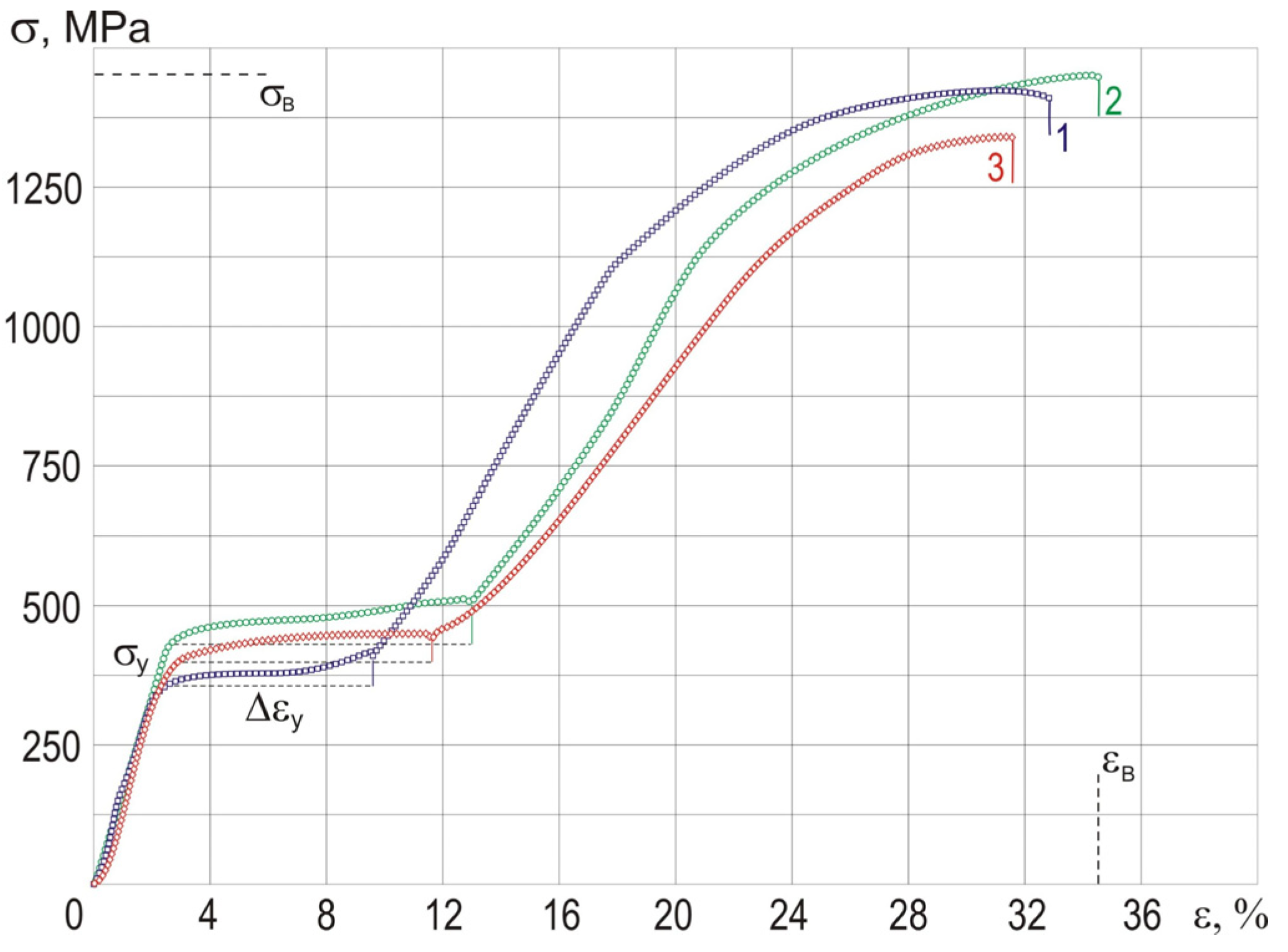
| M’s, °C | M’f, °C | A’s, °C | A’f, °C | ΔT, deg | εrev, % | εres, % | |
|---|---|---|---|---|---|---|---|
| TiNi | −36 | −164 | −22 | 25 | 55 | 6.2 | 0 |
| TiNi49.9–Ag0.1 | −40 | −145 | −14 | 13 | 60 | 6.5 | 0 |
| TiNi49.8–Ag0.2 | −38 | −108 | −27 | 27 | 68 | 4.7 | 0.2 |
| σy, MPa | σв, MPa | Δεy, % | εв, % | |
|---|---|---|---|---|
| TiNi | 350 ± 20 | 1370 ± 20 | 7 ± 0.5 | 32 ± 0.5 |
| TiNi49.9–Ag0.1 | 435 ± 20 | 1450 ± 20 | 10 ± 0.5 | 34 ± 0.5 |
| TiNi49.8–Ag0.2 | 400 ± 20 | 1330 ± 20 | 8 ± 0.5 | 31 ± 0.5 |
Publisher’s Note: MDPI stays neutral with regard to jurisdictional claims in published maps and institutional affiliations. |
© 2020 by the authors. Licensee MDPI, Basel, Switzerland. This article is an open access article distributed under the terms and conditions of the Creative Commons Attribution (CC BY) license (http://creativecommons.org/licenses/by/4.0/).
Share and Cite
Baigonakova, G.; Marchenko, E.; Chekalkin, T.; Kang, J.-h.; Weiss, S.; Obrosov, A. Influence of Silver Addition on Structure, Martensite Transformations and Mechanical Properties of TiNi–Ag Alloy Wires for Biomedical Application. Materials 2020, 13, 4721. https://doi.org/10.3390/ma13214721
Baigonakova G, Marchenko E, Chekalkin T, Kang J-h, Weiss S, Obrosov A. Influence of Silver Addition on Structure, Martensite Transformations and Mechanical Properties of TiNi–Ag Alloy Wires for Biomedical Application. Materials. 2020; 13(21):4721. https://doi.org/10.3390/ma13214721
Chicago/Turabian StyleBaigonakova, Gulsharat, Ekaterina Marchenko, Timofey Chekalkin, Ji-hoon Kang, Sabine Weiss, and Aleksei Obrosov. 2020. "Influence of Silver Addition on Structure, Martensite Transformations and Mechanical Properties of TiNi–Ag Alloy Wires for Biomedical Application" Materials 13, no. 21: 4721. https://doi.org/10.3390/ma13214721
APA StyleBaigonakova, G., Marchenko, E., Chekalkin, T., Kang, J. -h., Weiss, S., & Obrosov, A. (2020). Influence of Silver Addition on Structure, Martensite Transformations and Mechanical Properties of TiNi–Ag Alloy Wires for Biomedical Application. Materials, 13(21), 4721. https://doi.org/10.3390/ma13214721






